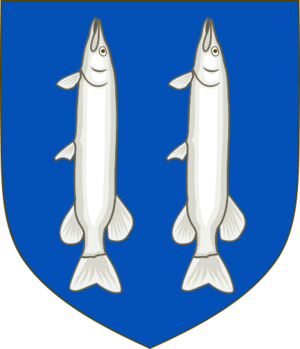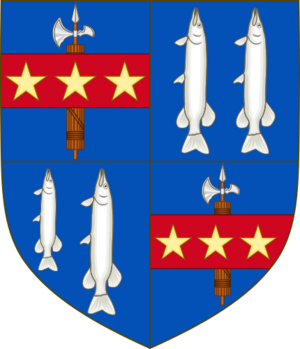Mancini family facts for kids
The House of Mancini was a very old and important family from Rome, Italy. They had many special titles and lands, like being Dukes of Nevers and Princes of the Holy Roman Empire. They were also French Peers and Spanish Grandees.
The Mancini family was part of many important groups, like the Order of the Golden Fleece and the Sovereign Order of Saint John of Jerusalem. They were well-known in Rome, and their history goes back a very long time.
Contents
Family Roots
The Mancini family came from Rome and has roots in Italy that go back over a thousand years. They believed they were related to an ancient Roman family called the Hostilia gens. This family included Lucius Hostilius Mancinus, who was a Roman leader around 145 BC. He was a commander of the Roman fleet during a big war called the Third Punic War.
Family Story
The Naples Branch
One part of the Mancini family moved to Naples in 1527. This branch was started by Domenico Nicola Mancini. A famous member of this group was Count Pasquale Stanislao Mancini (1817–1888). He was a brilliant lawyer and writer. He also served as a minister three times for the Kingdom of Italy. He worked in public education, justice, and foreign affairs.
Other lines came from the Naples branch. These include Federico Mancini and Aldo Mancini, who was a knight of important orders. The San Vittore line also came from here. It was started by Count Antonio Mancini in the 1800s.
The Roman Mancinis
In Rome, the Mancini family was sometimes called "de Lucij" because their family symbol had fish on it. Many family members held important positions in Rome. The first known member was Lucio Mancini, who lived around the year 990.
Over the centuries, different parts of the family became noble in many places. They were especially important in Fermo, where they held positions like "Priori" and "Consoli." The most important branches were the Sicily line and the Nevers line.
The Sicily Branch
One part of the family moved to Sicily in 1256. They were trying to escape problems in Rome. This branch included Barons of Tardello and other places. However, this line ended in the 1600s.
Another Sicily branch started when Francesco Mancini moved to Catania in the 1600s. He was related to Cardinal Giulio Mazzarino. The Mancini family became very important in Catania. The city even named streets and squares after them. Today, this family branch uses the name Mancini de Lucij.
The Nevers Branch
The Nevers branch of the Mancini family had many famous people:
- A. Paolo (1580–1637) started a special club for writers called the "Accademia degli Umoristi." Famous writers like Giovanni Battista Guarini attended it. He was the father of:
- 1. Lorenzo (1602–1650) was a Roman noble. He married Girolama Mazzarini, who was the sister of the famous Cardinal Mazarin. After Lorenzo passed away, his wife took their children to Paris. She hoped her powerful brother would help them marry well, and she was very successful. Lorenzo was the father of:
- a. Laura Mancini (1636–1657) married Louis de Bourbon. She became the mother of a famous French general, Louis Joseph de Bourbon, duc de Vendôme.
- b. Olympia Mancini (1638–1708) married Eugène-Maurice of Savoy. She became the mother of the famous Austrian general, Prince Eugene of Savoy.
- c. Marie Mancini (1639–1715) married Lorenzo Colonna. She had a special friendship with King Louis XIV of France.
- d. Philippe Mancini (1641–1707) was made Duke of Nevers by his uncle, Cardinal Mazarin. He was allowed to make coins. He was also a knight and a leader of the King's Musketeers. His grandson was:
- 1. Lorenzo (1602–1650) was a Roman noble. He married Girolama Mazzarini, who was the sister of the famous Cardinal Mazarin. After Lorenzo passed away, his wife took their children to Paris. She hoped her powerful brother would help them marry well, and she was very successful. Lorenzo was the father of:
* i. Louis-Jules Mancini-Mazarini, Duc de Nivernais (1716–1798). He was a Prince, a knight, a general, a diplomat, and a writer.
-
-
- e. Hortense Mancini (1646–1699) was known for her beauty. She left her husband and went to London. There, she became a close companion to King Charles II.
- f. Marie Anne Mancini (1649–1714) married Maurice Godefroy de la Tour d'Auvergne. She was a supporter of famous writers like Racine and La Fontaine.
- 2. Cardinal Francesco Maria Mancini (1606–1672) was important in choosing Pope Alexander VII.
-
The family's symbol also inspired the design for the French town of Liernais.
The San Vittore Branch
This is a branch of the Naples line of the Mancini family. It started in the 1800s with Count Antonio Filippo Luigi (1824–1890). He was a first lieutenant in the Neapolitan Army.
His son, Giuseppe Alessandro Luigi (1852–1903), married Maria Antonietta Marinelli in 1882. They had seven children. One of them was Carlo Alberto Antonio (1883–1940), who owned horses. He married Maria Concetta Cassone Simeoni-Wrbna in 1911.
Their son, Antonio Eugenio Andrea (1915–1990), was an officer in the Italian Army. He fought in World War II. He was captured by the Germans but managed to escape. He received the Military Cross for his bravery. His son, Count Adriano Fulvio Mario Mancini (1952), breeds Arabian horses and works in advertising. He is also a Commander of the Sovereign Order of Saint John of Jerusalem.
Important Buildings
- Mancini Palace in Rome
- Mancini de Lucij Palace, also in Rome
See also
 In Spanish: Familia Mancini para niños
In Spanish: Familia Mancini para niños



